The Role, Challenges, and Rewards of Becoming an EFR
If you were to ever be in a medical emergency, can you confidently say that you would know what to do?
If you are interested in public safety and would like to be able to help those in need quickly and without hesitation, consider becoming an Emergency First Responder.
Emergency First Responder is a broad term, used either to describe a specific certification level or those individuals who respond to medical emergencies. A first responder is the first medically trained personnel who comes in contact with a patient. This could be a passerby, citizen volunteer, or fire department, police, or emergency medical services personnel.
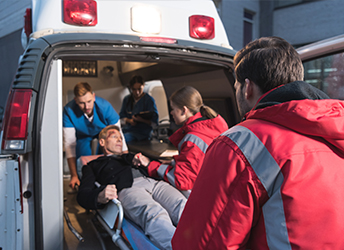
There is a lot of confusion online about who is responsible for administering medical help outside of hospitals. Terms like emergency first responder, emergency medical technician, paramedic, physician, etc. are used intermittently when talking about medical emergencies, and they can cause a headache if you are trying to figure out just what an Emergency First Responder is. There are multiple responders to medical emergencies around the world, and they have many different titles. Even so, they can all be divided into five distinct categories: non-trained first aid individuals, emergency medical technicians, paramedics, nurses and physicians, and finally, emergency first responders. The one thing they all have in common, they are the ones who run into danger to save lives, while most people run the other way.
Who Responds to Emergency Calls for Medical Help?
1. Non-Trained First Aid Providers
First aid is the first and immediate assistance given to any person suffering from a severe illness or injury. Ideally, it is performed by someone with basic medical training. There are many situations which may require first aid, and many countries have legislation, regulation, or guidance specifying a minimum level of first aid provision in certain conditions. However, the most important thing here is to know that first aid does not necessarily require any special equipment or prior knowledge, can be improvised with materials available at the time, and performed by people with little or no training. In this case, first aid is provided by non-trained individuals.
2. Emergency Medical Technicians
Emergency Medical Services (EMS), also called ambulance services or paramedic services, are emergency services which treat injuries requiring urgent medical response and provide out-of-hospital treatment, and transport to the next point of care, usually an emergency department ward in a hospital. To administer EMS, you have to receive training. In English-speaking countries, providers of EMS are called emergency medical technicians (EMTs), and paramedics. Some EMTs are paid employees, while others, especially in developing countries and rural areas, are volunteers. Training for employees of EMS varies widely throughout the world. In some counties, members with no medical training are qualified only to drive ambulances. Most systems around the globe have personnel who have been trained and carry first aid certifications, such as basic life support (BLS).
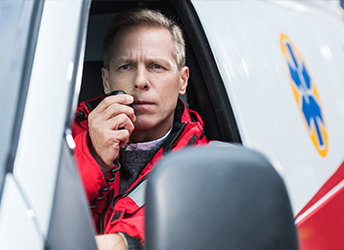
3. Paramedics
Paramedics are specialist healthcare professionals who have gone through additional training such as advanced life support (ALS) skills, and able to make autonomous decisions on the scene of the emergency. In some countries, the paramedic may be able to prevent hospitalization entirely, prescribe certain medications, or directly refer a patient to specialist services without taking them to the hospital. They encounter situations such as road accidents, plane crashes, fires and flooding. Essential emergency supplies that paramedics carry are nebulizers, CPR Pocket Masks, a portable resuscitator, ventilators and oxygen delivery equipment consisting of an oxygen tank, oxygen delivery mask, and a nasal cannula When people are seriously injured or critically ill and unable to breathe on their own, immediate attention is necessary and respiratory supplies are essential.
4. Physicians
Emergency medical technicians are typically supervised by a medical director, who is a physician. Physicians and nurses can also be found providing pre-hospital care to varying degrees in different countries. In some European countries, for instance, ambulance care is led by physicians.
5. Emergency First Responders
Finally, Emergency First Responders are people who are specially trained to provide out-of-hospital care in medical emergencies. There are many different types of emergency medical responders, each with varying levels of training, ranging from first aid to basic life support (BLS). An Emergency First Responder also has many similar sounding titles, like Emergency Medical Responder, Certified First Responder, Medical First Responder, or just First Responder. The bottom line is, this person has completed a specialized course and received certification in providing pre-hospital care for medical emergencies.
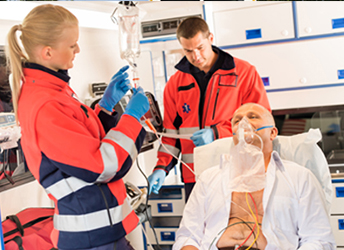
Emergency First Responders have a limited scope of practice and have the least amount of comprehensive education, clinical experience or clinical skills of emergency medical services (EMS) personnel. The EMR program is not intended to replace the roles of emergency medical technicians or paramedics and their wide range of specialties. However, it is the first step towards becoming a professional in pre-hospital care. Emergency First Responders typically provide necessary life support where pre-hospital health professionals are not available due to limited resources or infrastructure.
Certified Emergency First Responders (EFRs) are usually the earliest to arrive at an accident or scene of a medical emergency. As a crucial part of the emergency medical assistance team, a first responder quickly scans the emergency situations, calls for additional assistance, and administers first aid. People holding this title include firefighters, police officers, search and rescue professionals, emergency medical service workers, and hazardous materials personnel, amongst others.
Emergency First Responder at the Scene of an Accident
Once he arrives at the scene of an accident or emergency incident, the EFR assesses the situation, requests additional help when necessary (ambulance), and administers basic first aid. This could include controlling bleeding, bandaging wounds, providing cardiopulmonary resuscitation (CPR), or even assisting in childbirth, and taking care of immediate general medical issues. Some of the essential pieces of equipment that should be in their kit are disposable gloves, a surgical mask, even goggles. They should also carry waterless hand cleaner. Different emergencies require different safety kits, but the above can be used in almost every situation. While first responders often put the safety of the injured person above their own, they must also protect themselves.
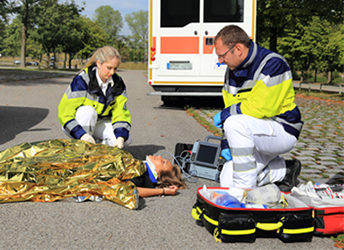
The first responder's goal is to provide primary, lifesaving interventions while waiting for additional emergency response assistance to arrive. In addition to providing medical care, an emergency first responder also helps stabilize the incident scene, protects property and, in cases of criminal activity, preserves evidence.
A first responder generally works full time in a job that involves high stress as he is often put into life or death situations. First responders need mental clarity, compassion, physical strength, people skills, and the ability to solve problems under pressure.
Challenges and Rewards of Becoming an Emergency First Responder
As you can now see, the term 'first responder' and 'emergency first responder' refer to the level of training, and title that certifies emergency personnel to provide basic medical care that is somewhere between first aid and basic emergency medical technician (EMT) care. As a certified first responder, you would also be responsible for calling other EMS providers to the scene and assisting them with patient care as necessary. Some first responders hold two or more designations; for example, a firefighter can also be an EFR. You'll find first responders working in search and rescue, hazardous materials and explosives units. Most first responders work has additional job titles, such as firefighter, law enforcement officer, EMT or paramedic - if you find helping others rewarding as an EFR, you can train further to become a paid medical professional who provides basic medical care.
It’s a challenging type of work.
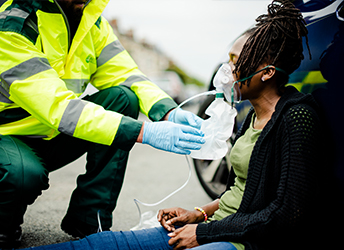
The role of the Emergency First Responder is physically, emotionally and mentally demanding. EFRs frequently encounter dangerous situations, including high-speed collision scenes, crime scenes, fires which might involve toxic smoke, and collapsing buildings. Work can be physically strenuous, including heavy lifting. Emergencies can occur at any time which means irregular hours, and accidents happen more often whenever people don’t work, including weekends, nights and holidays. EFRs face stressful situations, and more often than not uncooperative, upset or deceased victims.
Why would a person take on such responsibility for others’ well being?
A lot of the people involved report a feeling of pride and satisfaction in knowing they’ve made a tremendous difference in someone's life. Taking the hard choice of serving others in times of need is one of the ways to feel rewarded for being a responsible member of society. Your role as an emergency first responder will allow you to build relationships with people across your community. In addition to your patients, who will come from all walks of life, you will encounter police officers, firefighters, doctors, nurses, and others who play essential roles in protecting and saving lives locally. Knowing these people will strengthen your bonds in every aspect of community life. You don't need a college degree to become a certified emergency first responder. Instead, you earn a certification. To do so, you must first complete between 40 and 60 hours of training, depending on where you are taking the training program. After that, you might decide to become certified as an emergency medical technician, or a paramedic, which would qualify you to perform more advanced medical procedures and make an even more significant difference.





















 2755841275@qq.com
2755841275@qq.com 13159238790
13159238790